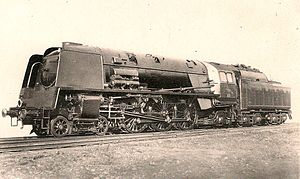NMBS / SNCB series 1
| NMBS / SNCB series 1 | |
|---|---|
| Numbering: | 1.001-1.035 |
| Number: | 35 |
| Manufacturer: | Tubize , Cockerill , La Meuse , Haine-St Pierre |
| Year of construction (s): | 1935, 1938 |
| Retirement: | 1962 |
| Axis formula : | 2'C'1 h4 |
| Gauge : | 1435 mm ( standard gauge ) |
| Length: | 14158 mm |
| Height: | 4280 mm |
| Width: | 3100 mm |
| Fixed wheelbase: | 4100 mm |
| Total wheelbase: | 11450 mm |
| Empty mass: | 114.2 t |
| Service mass: | 126 t |
| Top speed: | 120 km / h |
| Performance indicator: | 2500 PSi |
| Driving wheel diameter: | 1980 mm |
| Impeller diameter front: | 900 mm |
| Rear wheel diameter: | 1067 mm |
| Number of cylinders: | 4th |
| Cylinder diameter: | 420 mm |
| Piston stroke: | 720 mm |
| Boiler overpressure: | 18 bar |
| Grate area: | 5 m² |
| Radiant heating surface: | 19.72 m² |
| Tubular heating surface: | 215.06 m² |
| Superheater area : | 111.70 m² |
| Evaporation heating surface: | 234.78 m² |
| Tender: | 4th |
| Brake: | Westinghouse air brake handbrake |
| Control: | Walschaerts |
The steam locomotives of the NMBS / SNCB series 1 were one of the heaviest European Pacific locomotives with an operating weight of 126 tons . They were procured by the Belgian state railways NMBS / SNCB from 1935 to 1938 with a total of 35 pieces.
history
After the First World War , the Belgian State Railways received an extensive inventory of relatively new locomotives from the German deliveries after the Compiègne armistice , especially those from the former Prussian State Railways . After the NMBS / SNCB series 10 , which was delivered until 1912, it was not until the 1930s that new locomotives were required for high-quality express train services in international traffic due to the sharp increase in train weights and increasing competition from cars and aircraft. The 10 series came to its limits, especially on the steep route via Arlon to Luxembourg . The NMBS / SNCB therefore commissioned the development of a new express train Pacific, the design was significantly influenced by its chief engineer Raoul Notesse . Various Belgian manufacturers were involved in the delivery; the companies Tubize , Cockerill , La Meuse and Haine-St Pierre had formed a corresponding consortium for this purpose. The first locomotive was delivered by Tubize in May 1935, just in time for the 100th anniversary of the Belgian railways.
It was stipulated that the locomotives should reach a maximum speed of 120 km / h, on the long ramps of the Namur – Luxembourg railway line they should still carry trains weighing 400 tons at a continuous speed of 80 km / h. Test drives confirmed the expectations, compared to row 10 the usable power of up to 2700 PSi was up to 40% higher. In 1935, the State Railways received a first series of 15 pieces, followed by another 20 in 1938. The locomotives took over all important express train services on the main axis of the Belgian railway network between Ostend , Brussels and Liege , as well as the demanding uphill stretches to the German border at Aachen or to Luxembourg .
From the mid-1950s, the NMBS / SNCB procured large series of new diesel locomotives and electrified large parts of their network. From 1955, the new diesel locomotives of the NMBS / SNCB series 202 took over the most important express train services on the non-electrified lines, in the same year the line between Ostend and Liège was completely under contact wire. Row 1 was pushed to subordinate services. In 1962 all locomotives, with the exception of the 1,001, which had been retired due to an accident in 1954, were decommissioned.
Only one example, the 1.002 locomotive, was preserved. It was repaired for the 150th anniversary of the Belgian railways in 1985 and used for special trips. It is now in a non-operational condition at the Chemin de fer à vapeur des 3 vallées museum railway in Treignes in southern Wallonia in their museum collection.
technology
The class 1, like the class 10, was designed as a four-wheel locomotive with live steam for all four cylinders. The expected high demand for steam meant that the large fire box of the boiler made of high-quality nickel steel was equipped with two fire doors, and two heaters were used for this at times. Based on a French experience was Kylchap - exhaust installation with two blowguns installed, the flow channels for the steam were based on the findings of André Chapelon designed for optimal thermal conditions. The locomotive frame was designed as a bar frame with 115 mm thick frame cheeks, which were connected by cross members made of cast steel and the cylinder block, which was also made of cast steel as a monoblock. While the front bogie received an inner frame, the trailing axle had a delta towing frame , each with roller bearings . Externally, the locomotives were given a partially streamlined front with large smoke deflectors and a smoke chamber door with a sloping top .
literature
- Erhard Born: 2 C 1. Development and history of the Pacific locomotives. Franckh'sche Verlagshandlung, Stuttgart 1964.

